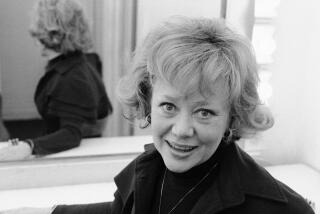Voice coach Bob Garrett finds the key of ‘Grey Gardens’
In the 1970s, Bob Garrett performed at Reno Sweeney, the same New York cabaret where Jackie Kennedy’s eccentric cousin “Little Edie” Bouvier Beale sang. More than three decades later, Garrett gave Drew Barrymore vocal training needed to simulate one of Little Edie’s performances for “Grey Gardens,” the HBO film based on the 1975 documentary of the same name.
“Reno Sweeney was a legendary place in New York,” says Garrett, who also coached Jessica Lange, who portrays Little Edie’s reclusive mother, “Big Edie,” in the film, released on DVD in July.
Born in the shadow of the Great White Way, Garrett set his sights on Broadway when he was only 5 years old and saw his first show, “Peter Pan.”
“My mother was an actress on Broadway before she was married, and she took me to the theater because she loved the theater,” he said. “The story is that I looked at her and I said, ‘What is this?’ She said, ‘This is Broadway.’ And I said, ‘Well, that’s what I’m going to do!’ ”
At 13, Garrett began studying voice with Rose Allen and Sue Seton -- who also trained Luciano Pavarotti and Bernadette Peters, among others. He landed his first Broadway role in “Fiddler on the Roof” in 1970.
“I worked with Jerome Robbins, who was a complete genius,” Garrett said. “He taught me that songs are really monologues, and they have to be approached that way, not as technical steps from one note to another.”
After booking himself at Reno Sweeney and other popular New York cabarets, Garrett was spotted by executives from Motown Records, who hired him as a staff songwriter.
After years of composing for record companies, writing for TV and directing for theater, he began vocal coaching on projects including 2001’s “Life With Judy Garland: Me and My Shadows,” the 2004 film version of “The Phantom of the Opera,” 2007’s “Lucky You” and “Grey Gardens,” which recently received 17 Emmy nominations.
“Singing is not just notes, and it’s not just having a great voice,” Garrett said. “It’s about being able to emote and tell that story.”
Do-re-mi: Barrymore and Lange always began their sessions with 10 exercises based on the methods of Garrett’s legendary teachers, Allen and Seton.
“My voice teachers’ technique was a very simple one that addressed four things -- breath control, being in the mask of the voice, sending the sound out instead of pulling it back, and relaxation,” Garrett said. “You’ve got to be emotional; you’ve got to tell a story. In other words, the technique helps the emotion, and the emotion helps the technique.”
What’s my motivation? Garrett approaches each song from a character perspective. “Because I was an actor, I understand how to work with other actors,” he said. “My whole concept with Jessica was totally based on one line in that beautiful script, which was: ‘I was never happier in my life than when I was singing.’ She felt that that informed the character for her in a very profound way. Drew’s character was different. She was about dreams and wanting attention and recognition. So her material was much broader and bigger and sort of shocking, in a way, because she wanted that attention.”
Tipping the scales: Garrett has a special system to accommodate actors who don’t read music. Traditional notation “is very complicated for somebody who’s not used to looking at music -- to see staffs and flats and sharps and all that,” he said. “So I created this visual dot system for Drew on ‘Lucky You,’ and I have used it since with Jessica. At the end of the first week, I was working with Jessica, and she said, ‘I love the dots!’ ”
Witchy woman: Lange performed several numbers in the film, including the jazz standard “Tea for Two.” “She said, ‘We have to do it exactly like it was done in the documentary, because it’s too iconic a moment,’ ” Garrett said.
“So I took the DVD and put it in my computer and reflected it in the mirror of the rehearsal room. We worked for months on this. And I put Jessica next to the DVD reflection and me next to her. I said, ‘We won’t have this until the three of us are doing exactly the same thing, and I mean down to the fingernails.’ And one day -- it was so hilarious -- I said to her, ‘We haven’t really worked with a hat yet.’ Well, it was Halloween in Toronto, and I found a store that sold costumes, and I bought a witch’s hat. I brought it into the rehearsal studio, and she put it on, and we worked with the witch’s hat! A really important thing with actors in this process of vocal coaching is humor.”
More to Read
The biggest entertainment stories
Get our big stories about Hollywood, film, television, music, arts, culture and more right in your inbox as soon as they publish.
You may occasionally receive promotional content from the Los Angeles Times.






